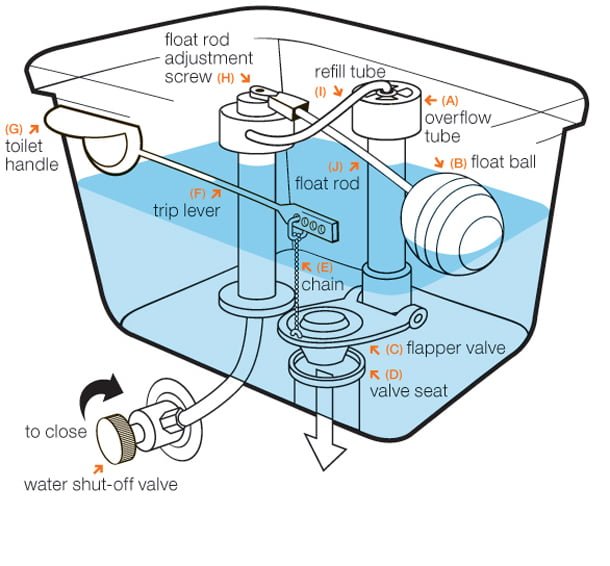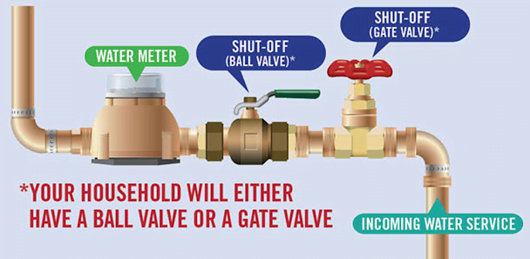Leak Detection
Water is our most precious resource. Preventing water waste helps to conserve this vital resource while saving money. The main sources of water waste are leaks, indoor overuse, and outdoor over-watering of lawns and gardens.
You may not realize you have a leak until you receive your water bill. Many leaks may go unnoticed but they can be costly.
Using your water meter to discover water leaks
To find out whether or not you may have a leak in your home using your water meter, follow these steps:
- Locate the low flow indicator or sweep hand on the water meter face. If you are unsure of where this is located on your water meter, visit our water meter page.
- Turn a tap on and run the water slowly. Look at the low flow indicator and observe it rotating. Turn the tap off.
- Check around the house to ensure that you are not using water. Turn off all taps, do not use any water and check to ensure outside hoses are turned off.
- Go back to the water meter and observe the low flow indicator; it shouldn’t be rotating.
- If the low flow indicator is not indicating flow, you do not have a leak.
- If the low flow indicator is indicating flow by rotating or displaying a plus sign, you may have a leak.
You may wish to contact a qualified tradesperson to help you find and repair any leaks.
For more information about your water meter, look at our water meter page

Follow these steps to check your toilet for leaks:
- Put a small amount of food colouring in the toilet tank.
- Wait 10 minutes, then check to see if water in the toilet bowl is coloured. If it is, the toilet flapper could be leaking. This is relatively simple and inexpensive to replace.
- While the toilet top is removed, look to see if the water level is close to the overflow pipe. The overflow pipe is a plastic pipe with an open end just below the top of the tank.
- If the water level is close, or overflowing into the pipe, this could be where the water is leaking.
- If the tank water level is too high, you should adjust the ball valve which controls the amount of water in your toilet tank.
You may wish to contact a qualified tradesperson to help you find and repair any leaks in your toilet.
- Turn off anything using water in your home. This includes your washing machine, dishwasher, and all faucets.
- Start in the lowest part of your home, usually your basement or crawlspace. Look for any pooled water and listen for any running water. If everything is shut off in the house, no water should be flowing. If you do hear running water, try to trace the pipe. Make note of the location and call a licensed plumber to confirm the leak and repair it.
- Walk through the rest of your house. Make note of any dripping pipes under sinks, wet or discoloured carpet, walls, or ceilings. These can often indicate leaking pipes or a leaking roof and can lead to structural damage, mold and mildew.
- Pay special attention to all faucets, in sinks, laundry tubs, baths and showers. Make note of any drips and make sure to repair them promptly. Small leaks like this really add up quickly!
- Inspect all water-using appliances. Most modern appliances have electronic leak sensors placed under them, and they will alert you as soon as water starts to collect underneath the appliance. Call a qualified appliance repair person to fix any leaks noted.
- Locate your hot water heater. The pressure relief valve allows the hot water heater to drain water if the pressure becomes too great. However, many times this valve is directly connected to a drain making it difficult to see the problem. Without touching your pressure relief valve, listen for water flowing through any connected hoses or look at the end of the hose for running water. If you have a leak that needs to be repaired speak to a certified hot water heater specialist.
- Walk outdoors and check any spigots, hoses or lawn irrigation systems for persistent leaks. If you have an underground irrigation system, look for soft or muddy areas that can indicate an underground leak.
- Examine the ground from the base of the foundation out to the road where your water service line is. Again, look for any soft and muddy areas, or pooled water. This could indicate a leak in the service line. If you suspect a leak in your water service line, contact Norfolk County at the Delhi Administration Building at 519-426-5870 or 226-NORFOLK.
Close the inside building control shut-off valve and open faucets to relieve pressure in the lines. If there is no shut-off valve, close the water supply to toilets, sinks, tubs and washing machines that often have individual shut-off valves.

If you have a seasonal home and would like the water shut off while the building is not in use, please call 519-426-5870 or 226-NORFOLK for fee details and to arrange an appointment.
To arrange for account payments while you are away, contact ERTH Corporation at 1-877-485-6050 or visit ERTH Corporation’s website.
